Financial Accounting Assignment: Comprehensive Solutions and Analysis
VerifiedAdded on 2022/12/27
|11
|1485
|70
Homework Assignment
AI Summary
This document provides a comprehensive set of solutions for an advanced financial accounting assignment. The solutions cover a range of topics, including asset acquisition, journal entries for revaluation losses, debenture accounting (issuance, interest, and redemption), lease accounting (present value calculations, journal entries for both lessee and lessor), deferred tax calculations, and foreign currency translation. Each question is answered with detailed step-by-step explanations, including journal entries, calculations, and relevant accounting principles. The document also includes a list of references to support the solutions provided. This resource is valuable for students studying financial accounting, providing a clear understanding of complex accounting concepts and practical application through detailed examples and explanations.
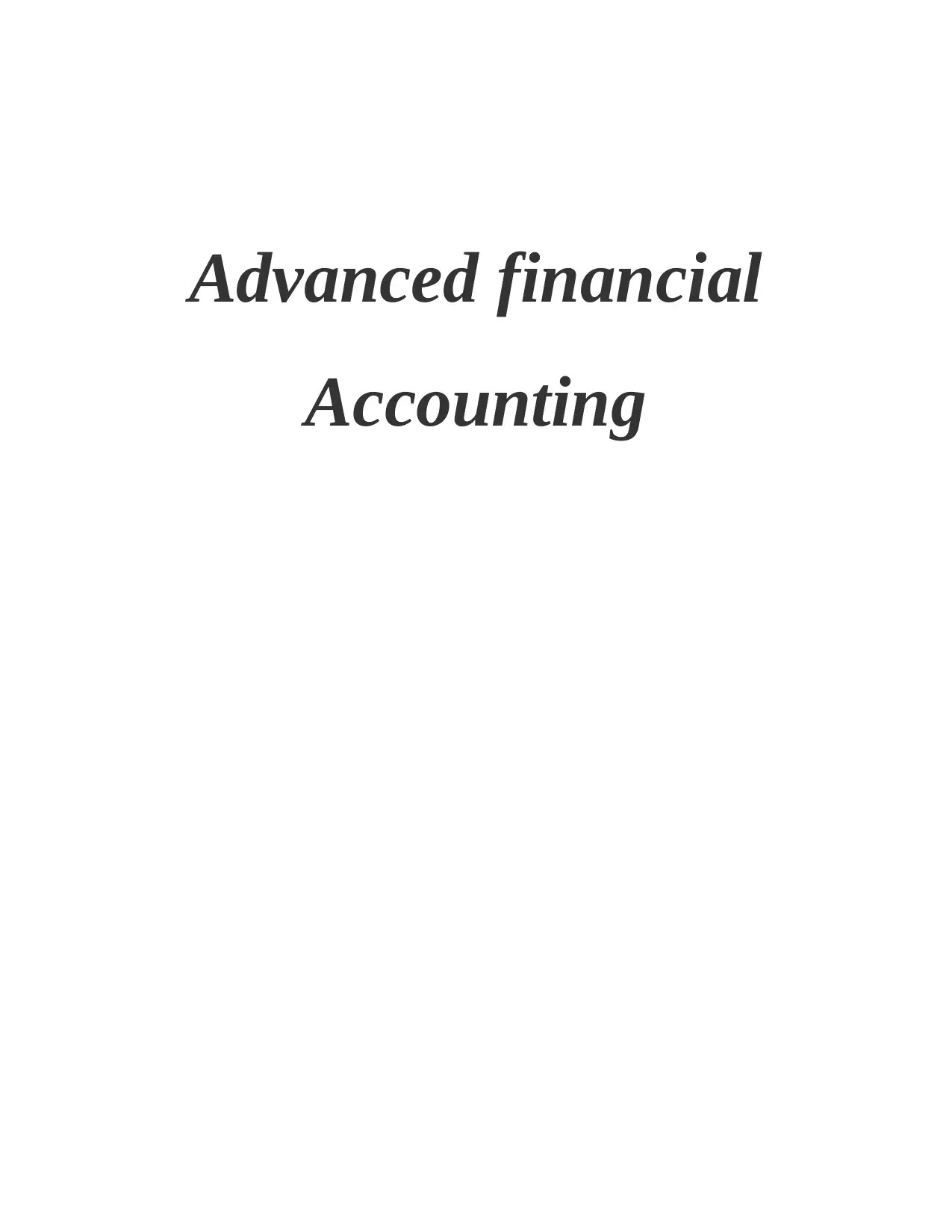
Advanced financial
Accounting
Accounting
Paraphrase This Document
Need a fresh take? Get an instant paraphrase of this document with our AI Paraphraser
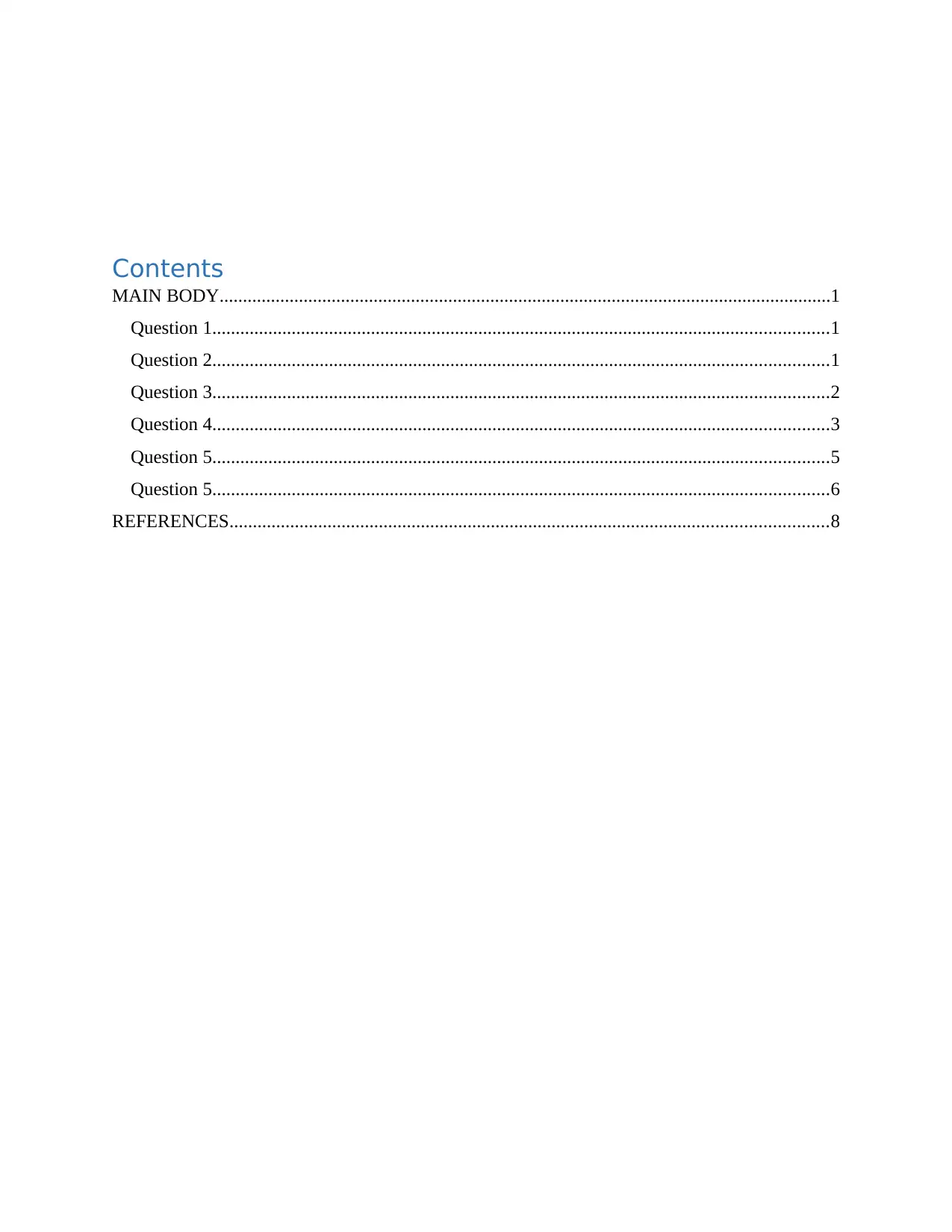
Contents
MAIN BODY...................................................................................................................................1
Question 1....................................................................................................................................1
Question 2....................................................................................................................................1
Question 3....................................................................................................................................2
Question 4....................................................................................................................................3
Question 5....................................................................................................................................5
Question 5....................................................................................................................................6
REFERENCES................................................................................................................................8
MAIN BODY...................................................................................................................................1
Question 1....................................................................................................................................1
Question 2....................................................................................................................................1
Question 3....................................................................................................................................2
Question 4....................................................................................................................................3
Question 5....................................................................................................................................5
Question 5....................................................................................................................................6
REFERENCES................................................................................................................................8

⊘ This is a preview!⊘
Do you want full access?
Subscribe today to unlock all pages.

Trusted by 1+ million students worldwide
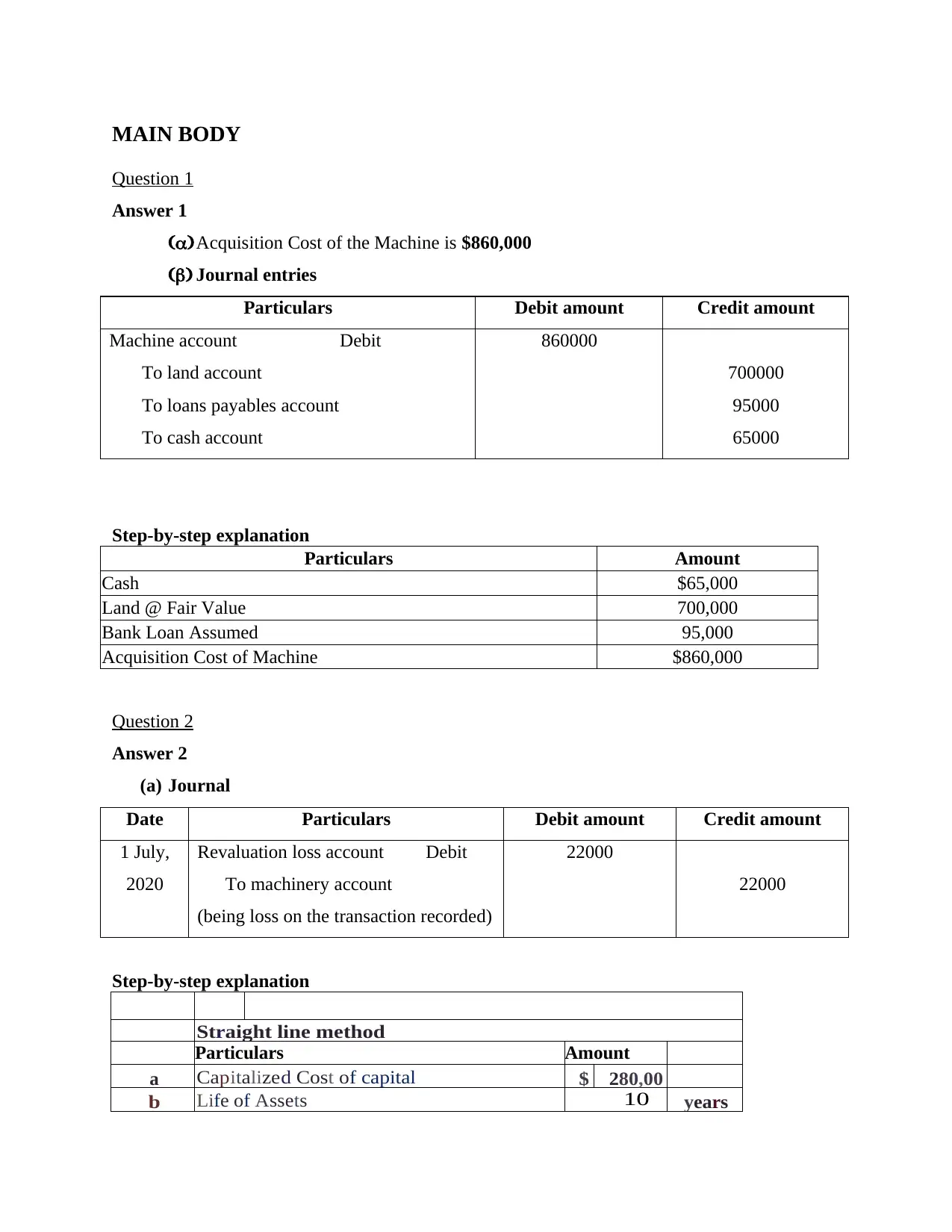
MAIN BODY
Question 1
Answer 1
(a)Acquisition Cost of the Machine is $860,000
(b) Journal entries
Particulars Debit amount Credit amount
Machine account Debit
To land account
To loans payables account
To cash account
860000
700000
95000
65000
Step-by-step explanation
Particulars Amount
Cash $65,000
Land @ Fair Value 700,000
Bank Loan Assumed 95,000
Acquisition Cost of Machine $860,000
Question 2
Answer 2
(a) Journal
Date Particulars Debit amount Credit amount
1 July,
2020
Revaluation loss account Debit
To machinery account
(being loss on the transaction recorded)
22000
22000
Step-by-step explanation
Straight line method
Particulars Amount
a Capitalized Cost of capital $ 280,00
b Life of Assets 10 years
Question 1
Answer 1
(a)Acquisition Cost of the Machine is $860,000
(b) Journal entries
Particulars Debit amount Credit amount
Machine account Debit
To land account
To loans payables account
To cash account
860000
700000
95000
65000
Step-by-step explanation
Particulars Amount
Cash $65,000
Land @ Fair Value 700,000
Bank Loan Assumed 95,000
Acquisition Cost of Machine $860,000
Question 2
Answer 2
(a) Journal
Date Particulars Debit amount Credit amount
1 July,
2020
Revaluation loss account Debit
To machinery account
(being loss on the transaction recorded)
22000
22000
Step-by-step explanation
Straight line method
Particulars Amount
a Capitalized Cost of capital $ 280,00
b Life of Assets 10 years
Paraphrase This Document
Need a fresh take? Get an instant paraphrase of this document with our AI Paraphraser
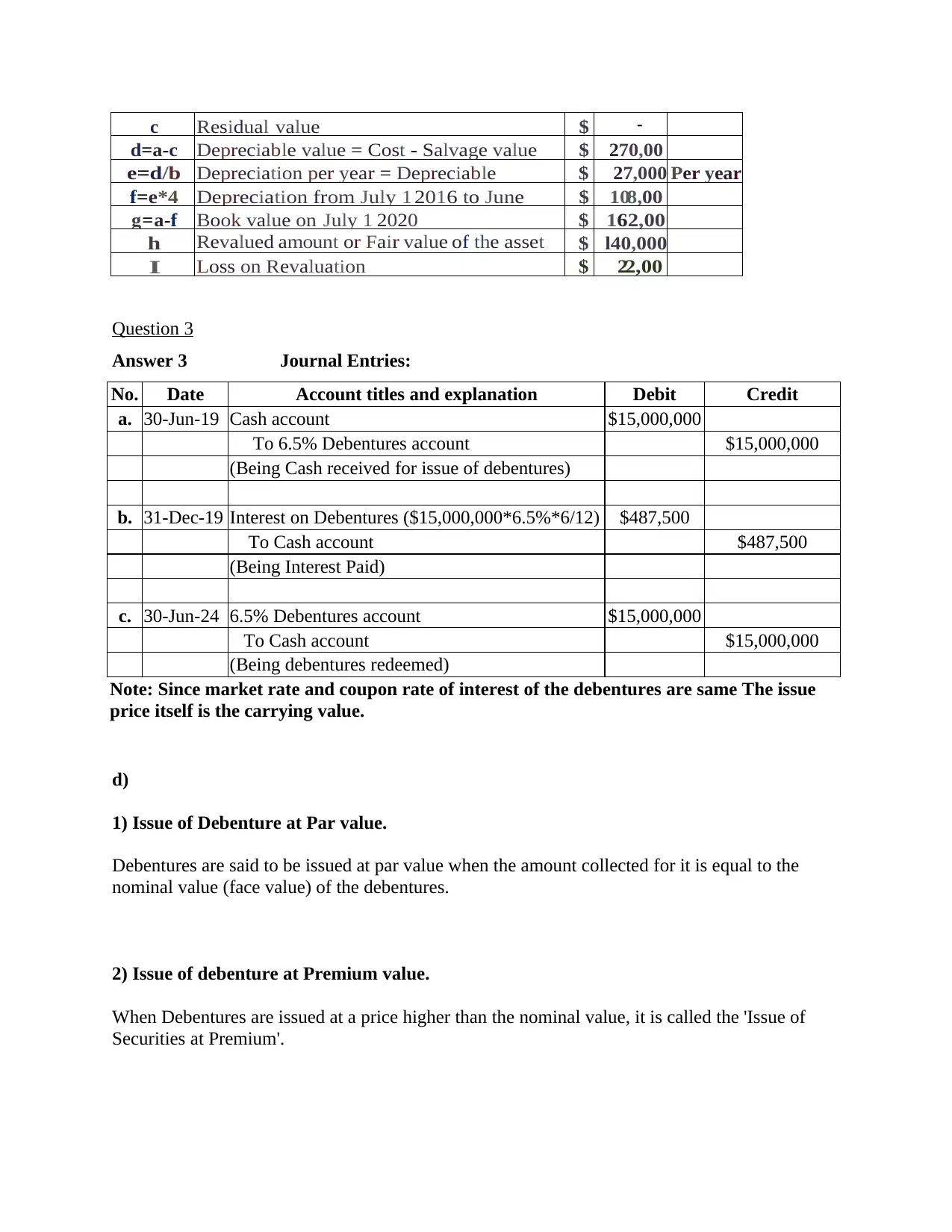
c Residual value $ -
d=a-c Depreciable value = Cost - Salvage value $ 270,00
e=d/b Depreciation per year = Depreciable $ 27,000 Per year
f=e*4 Depreciation from July 1 2016 to June $ 108,00
g=a-f Book value on July 1 2020 $ 162,00
h Revalued amount or Fair value of the asset $ l40,000
I Loss on Revaluation $ 22,00
Question 3
Answer 3 Journal Entries:
No. Date Account titles and explanation Debit Credit
a. 30-Jun-19 Cash account $15,000,000
To 6.5% Debentures account $15,000,000
(Being Cash received for issue of debentures)
b. 31-Dec-19 Interest on Debentures ($15,000,000*6.5%*6/12) $487,500
To Cash account $487,500
(Being Interest Paid)
c. 30-Jun-24 6.5% Debentures account $15,000,000
To Cash account $15,000,000
(Being debentures redeemed)
Note: Since market rate and coupon rate of interest of the debentures are same The issue
price itself is the carrying value.
d)
1) Issue of Debenture at Par value.
Debentures are said to be issued at par value when the amount collected for it is equal to the
nominal value (face value) of the debentures.
2) Issue of debenture at Premium value.
When Debentures are issued at a price higher than the nominal value, it is called the 'Issue of
Securities at Premium'.
d=a-c Depreciable value = Cost - Salvage value $ 270,00
e=d/b Depreciation per year = Depreciable $ 27,000 Per year
f=e*4 Depreciation from July 1 2016 to June $ 108,00
g=a-f Book value on July 1 2020 $ 162,00
h Revalued amount or Fair value of the asset $ l40,000
I Loss on Revaluation $ 22,00
Question 3
Answer 3 Journal Entries:
No. Date Account titles and explanation Debit Credit
a. 30-Jun-19 Cash account $15,000,000
To 6.5% Debentures account $15,000,000
(Being Cash received for issue of debentures)
b. 31-Dec-19 Interest on Debentures ($15,000,000*6.5%*6/12) $487,500
To Cash account $487,500
(Being Interest Paid)
c. 30-Jun-24 6.5% Debentures account $15,000,000
To Cash account $15,000,000
(Being debentures redeemed)
Note: Since market rate and coupon rate of interest of the debentures are same The issue
price itself is the carrying value.
d)
1) Issue of Debenture at Par value.
Debentures are said to be issued at par value when the amount collected for it is equal to the
nominal value (face value) of the debentures.
2) Issue of debenture at Premium value.
When Debentures are issued at a price higher than the nominal value, it is called the 'Issue of
Securities at Premium'.
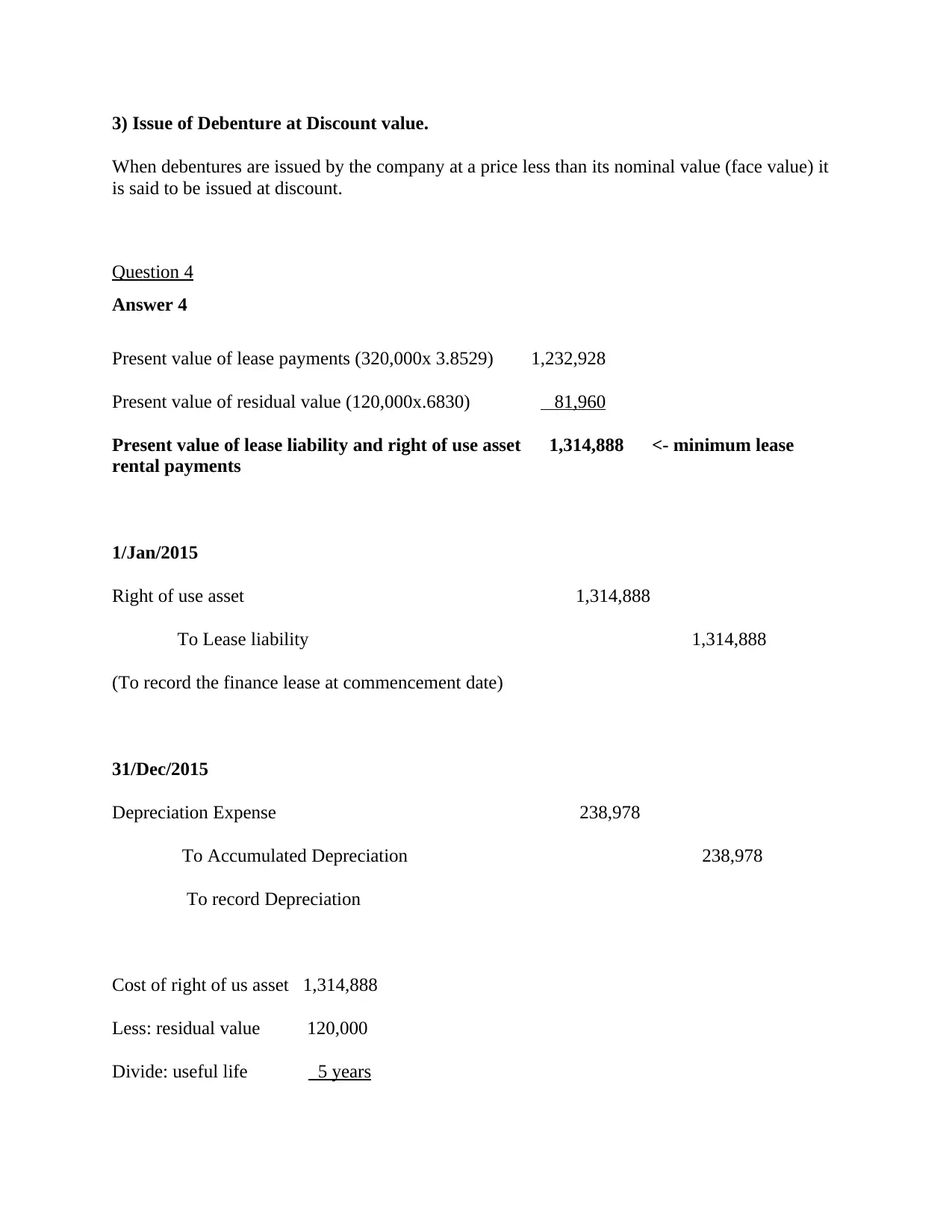
3) Issue of Debenture at Discount value.
When debentures are issued by the company at a price less than its nominal value (face value) it
is said to be issued at discount.
Question 4
Answer 4
Present value of lease payments (320,000x 3.8529) 1,232,928
Present value of residual value (120,000x.6830) 81,960
Present value of lease liability and right of use asset 1,314,888 <- minimum lease
rental payments
1/Jan/2015
Right of use asset 1,314,888
To Lease liability 1,314,888
(To record the finance lease at commencement date)
31/Dec/2015
Depreciation Expense 238,978
To Accumulated Depreciation 238,978
To record Depreciation
Cost of right of us asset 1,314,888
Less: residual value 120,000
Divide: useful life 5 years
When debentures are issued by the company at a price less than its nominal value (face value) it
is said to be issued at discount.
Question 4
Answer 4
Present value of lease payments (320,000x 3.8529) 1,232,928
Present value of residual value (120,000x.6830) 81,960
Present value of lease liability and right of use asset 1,314,888 <- minimum lease
rental payments
1/Jan/2015
Right of use asset 1,314,888
To Lease liability 1,314,888
(To record the finance lease at commencement date)
31/Dec/2015
Depreciation Expense 238,978
To Accumulated Depreciation 238,978
To record Depreciation
Cost of right of us asset 1,314,888
Less: residual value 120,000
Divide: useful life 5 years
⊘ This is a preview!⊘
Do you want full access?
Subscribe today to unlock all pages.

Trusted by 1+ million students worldwide
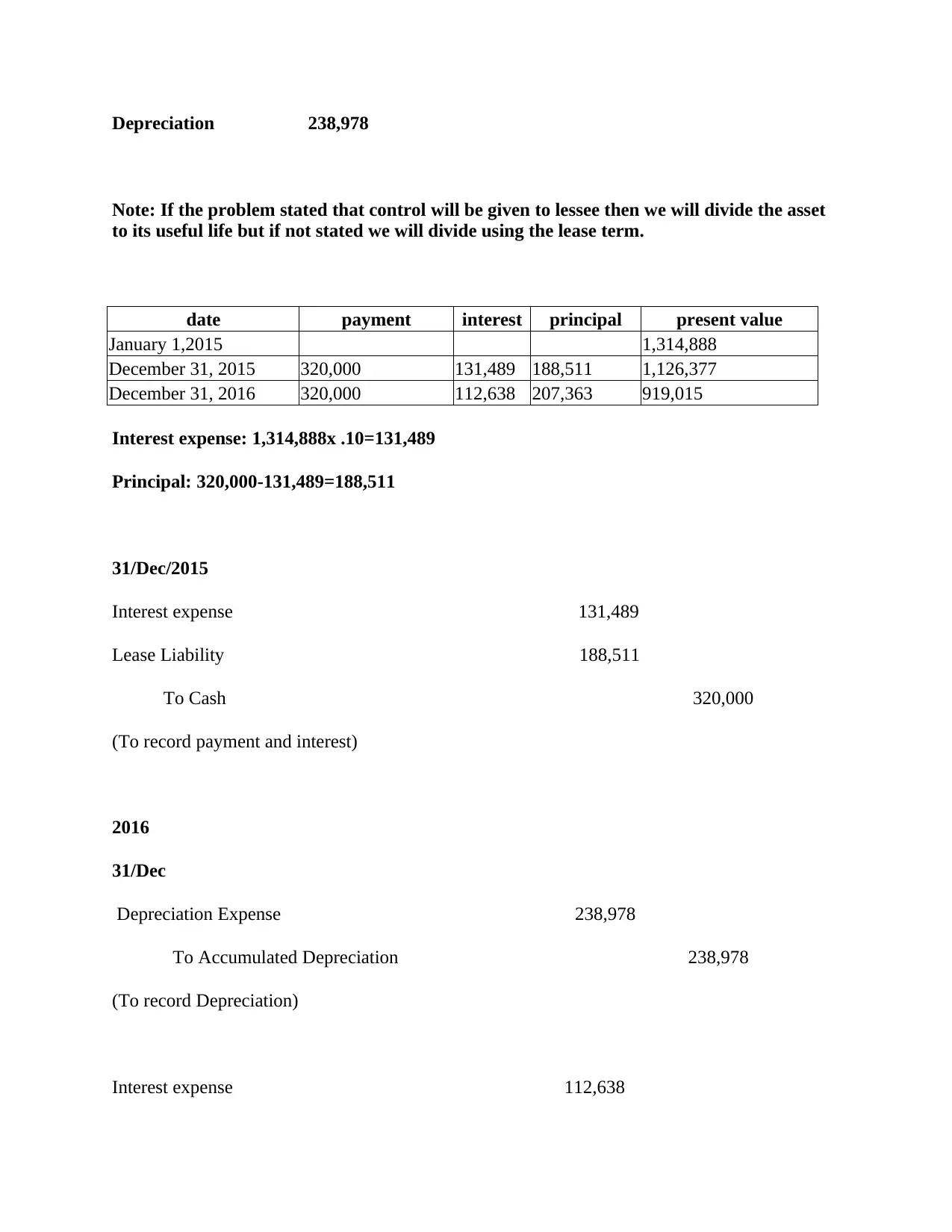
Depreciation 238,978
Note: If the problem stated that control will be given to lessee then we will divide the asset
to its useful life but if not stated we will divide using the lease term.
date payment interest principal present value
January 1,2015 1,314,888
December 31, 2015 320,000 131,489 188,511 1,126,377
December 31, 2016 320,000 112,638 207,363 919,015
Interest expense: 1,314,888x .10=131,489
Principal: 320,000-131,489=188,511
31/Dec/2015
Interest expense 131,489
Lease Liability 188,511
To Cash 320,000
(To record payment and interest)
2016
31/Dec
Depreciation Expense 238,978
To Accumulated Depreciation 238,978
(To record Depreciation)
Interest expense 112,638
Note: If the problem stated that control will be given to lessee then we will divide the asset
to its useful life but if not stated we will divide using the lease term.
date payment interest principal present value
January 1,2015 1,314,888
December 31, 2015 320,000 131,489 188,511 1,126,377
December 31, 2016 320,000 112,638 207,363 919,015
Interest expense: 1,314,888x .10=131,489
Principal: 320,000-131,489=188,511
31/Dec/2015
Interest expense 131,489
Lease Liability 188,511
To Cash 320,000
(To record payment and interest)
2016
31/Dec
Depreciation Expense 238,978
To Accumulated Depreciation 238,978
(To record Depreciation)
Interest expense 112,638
Paraphrase This Document
Need a fresh take? Get an instant paraphrase of this document with our AI Paraphraser
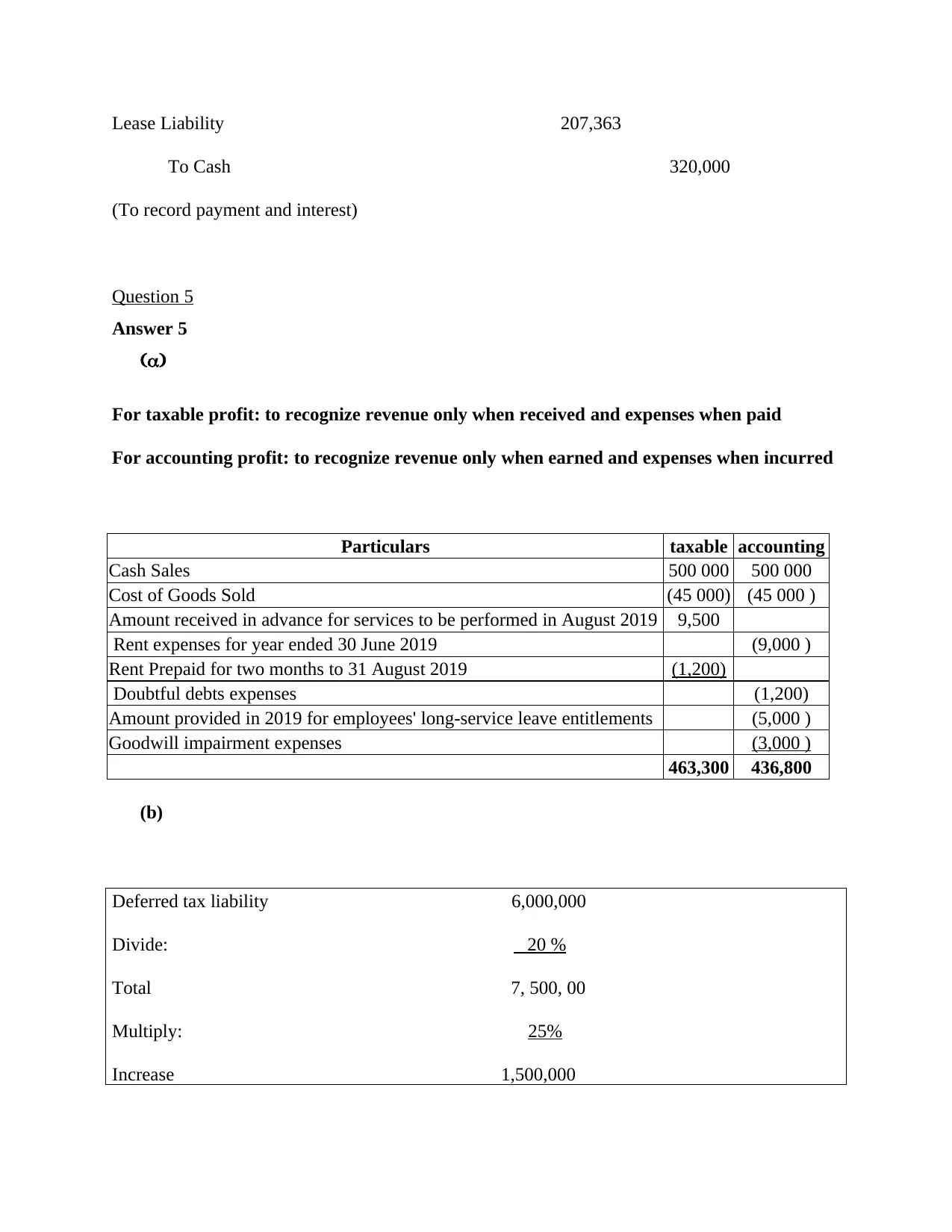
Lease Liability 207,363
To Cash 320,000
(To record payment and interest)
Question 5
Answer 5
(a)
For taxable profit: to recognize revenue only when received and expenses when paid
For accounting profit: to recognize revenue only when earned and expenses when incurred
Particulars taxable accounting
Cash Sales 500 000 500 000
Cost of Goods Sold (45 000) (45 000 )
Amount received in advance for services to be performed in August 2019 9,500
Rent expenses for year ended 30 June 2019 (9,000 )
Rent Prepaid for two months to 31 August 2019 (1,200)
Doubtful debts expenses (1,200)
Amount provided in 2019 for employees' long-service leave entitlements (5,000 )
Goodwill impairment expenses (3,000 )
463,300 436,800
(b)
Deferred tax liability 6,000,000
Divide: 20 %
Total 7, 500, 00
Multiply: 25%
Increase 1,500,000
To Cash 320,000
(To record payment and interest)
Question 5
Answer 5
(a)
For taxable profit: to recognize revenue only when received and expenses when paid
For accounting profit: to recognize revenue only when earned and expenses when incurred
Particulars taxable accounting
Cash Sales 500 000 500 000
Cost of Goods Sold (45 000) (45 000 )
Amount received in advance for services to be performed in August 2019 9,500
Rent expenses for year ended 30 June 2019 (9,000 )
Rent Prepaid for two months to 31 August 2019 (1,200)
Doubtful debts expenses (1,200)
Amount provided in 2019 for employees' long-service leave entitlements (5,000 )
Goodwill impairment expenses (3,000 )
463,300 436,800
(b)
Deferred tax liability 6,000,000
Divide: 20 %
Total 7, 500, 00
Multiply: 25%
Increase 1,500,000
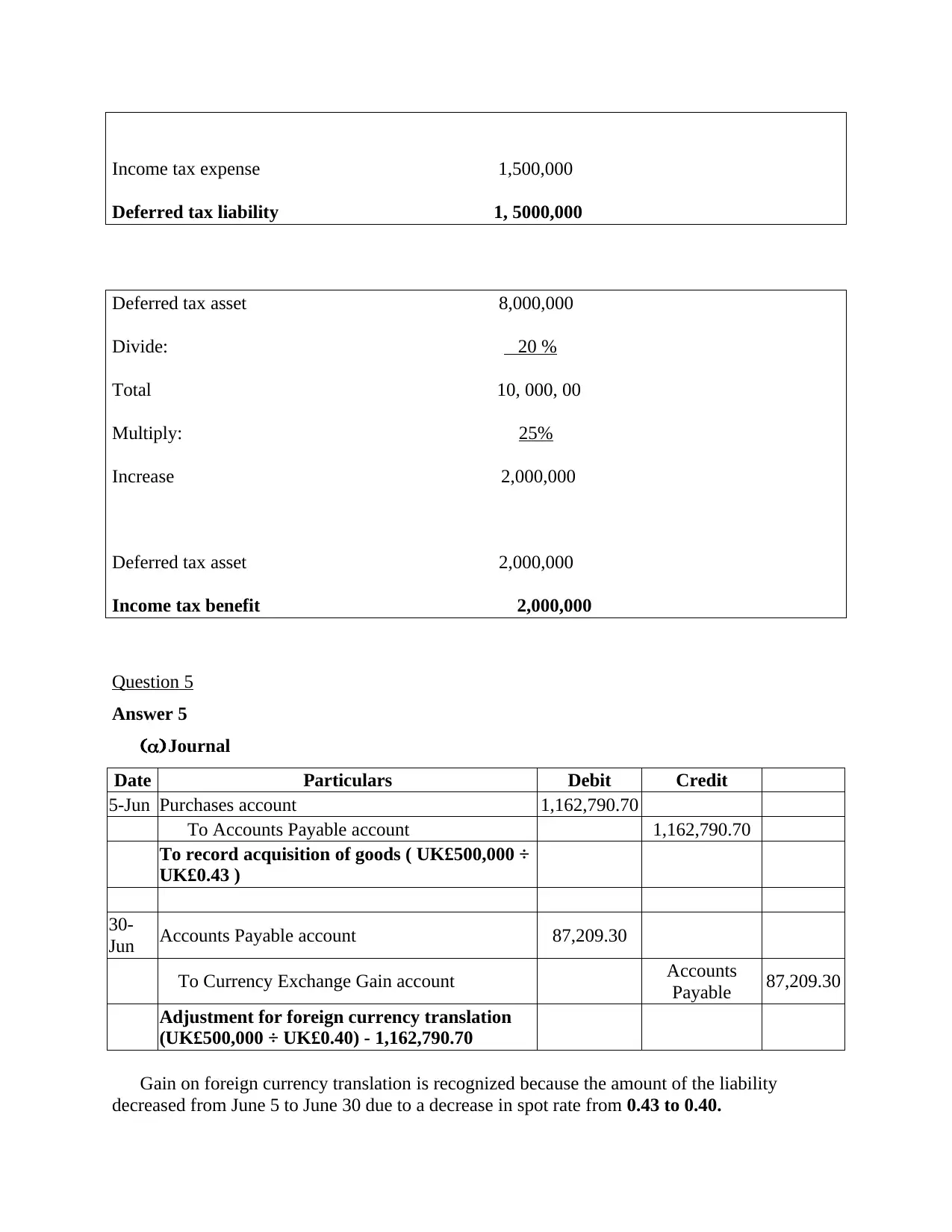
Income tax expense 1,500,000
Deferred tax liability 1, 5000,000
Deferred tax asset 8,000,000
Divide: 20 %
Total 10, 000, 00
Multiply: 25%
Increase 2,000,000
Deferred tax asset 2,000,000
Income tax benefit 2,000,000
Question 5
Answer 5
(a)Journal
Date Particulars Debit Credit
5-Jun Purchases account 1,162,790.70
To Accounts Payable account 1,162,790.70
To record acquisition of goods ( UK£500,000 ÷
UK£0.43 )
30-
Jun Accounts Payable account 87,209.30
To Currency Exchange Gain account Accounts
Payable 87,209.30
Adjustment for foreign currency translation
(UK£500,000 ÷ UK£0.40) - 1,162,790.70
Gain on foreign currency translation is recognized because the amount of the liability
decreased from June 5 to June 30 due to a decrease in spot rate from 0.43 to 0.40.
Deferred tax liability 1, 5000,000
Deferred tax asset 8,000,000
Divide: 20 %
Total 10, 000, 00
Multiply: 25%
Increase 2,000,000
Deferred tax asset 2,000,000
Income tax benefit 2,000,000
Question 5
Answer 5
(a)Journal
Date Particulars Debit Credit
5-Jun Purchases account 1,162,790.70
To Accounts Payable account 1,162,790.70
To record acquisition of goods ( UK£500,000 ÷
UK£0.43 )
30-
Jun Accounts Payable account 87,209.30
To Currency Exchange Gain account Accounts
Payable 87,209.30
Adjustment for foreign currency translation
(UK£500,000 ÷ UK£0.40) - 1,162,790.70
Gain on foreign currency translation is recognized because the amount of the liability
decreased from June 5 to June 30 due to a decrease in spot rate from 0.43 to 0.40.
⊘ This is a preview!⊘
Do you want full access?
Subscribe today to unlock all pages.

Trusted by 1+ million students worldwide

(b)
Companies need to translate foreign currency transactions into local currency in order to
reconcile all financial statements in terms of local or functional currency. When it comes to
accounting, the financial statements have to be recorded in a single currency. This is why there is
a need to perform foreign currency translation (Porter, 2019). It is important because each
country has a different currency from one another. The exchange rate or the price of one
currency in terms of another, helps to determine a nation's economic health and hence the well-
being of all the people residing in it.
(c)
The movement must be recognized in the books as gain or loss from foreign currency
translation. When selling products or services to customers in a foreign currency, the value of
that currency changes based on the exchange rate. If the value of the currency goes up or down
after the invoice of a customer but before collecting payment, then it have made a foreign
currency gain or loss on that invoice (Herawati, 2018).
IAS 21 or also known as "The Effects of Changes in Foreign Exchange Rates" outlines
how to account for foreign currency transactions and operations in financial statements, and also
how to translate financial statements into a presentation currency. An entity is required to
determine a functional currency (for each of its operations if necessary) based on the primary
economic environment in which it operates and generally records foreign currency transactions
using the spot conversion rate to that functional currency on the date of the transaction (Hassan
and Marston, 2019).
Companies need to translate foreign currency transactions into local currency in order to
reconcile all financial statements in terms of local or functional currency. When it comes to
accounting, the financial statements have to be recorded in a single currency. This is why there is
a need to perform foreign currency translation (Porter, 2019). It is important because each
country has a different currency from one another. The exchange rate or the price of one
currency in terms of another, helps to determine a nation's economic health and hence the well-
being of all the people residing in it.
(c)
The movement must be recognized in the books as gain or loss from foreign currency
translation. When selling products or services to customers in a foreign currency, the value of
that currency changes based on the exchange rate. If the value of the currency goes up or down
after the invoice of a customer but before collecting payment, then it have made a foreign
currency gain or loss on that invoice (Herawati, 2018).
IAS 21 or also known as "The Effects of Changes in Foreign Exchange Rates" outlines
how to account for foreign currency transactions and operations in financial statements, and also
how to translate financial statements into a presentation currency. An entity is required to
determine a functional currency (for each of its operations if necessary) based on the primary
economic environment in which it operates and generally records foreign currency transactions
using the spot conversion rate to that functional currency on the date of the transaction (Hassan
and Marston, 2019).
Paraphrase This Document
Need a fresh take? Get an instant paraphrase of this document with our AI Paraphraser
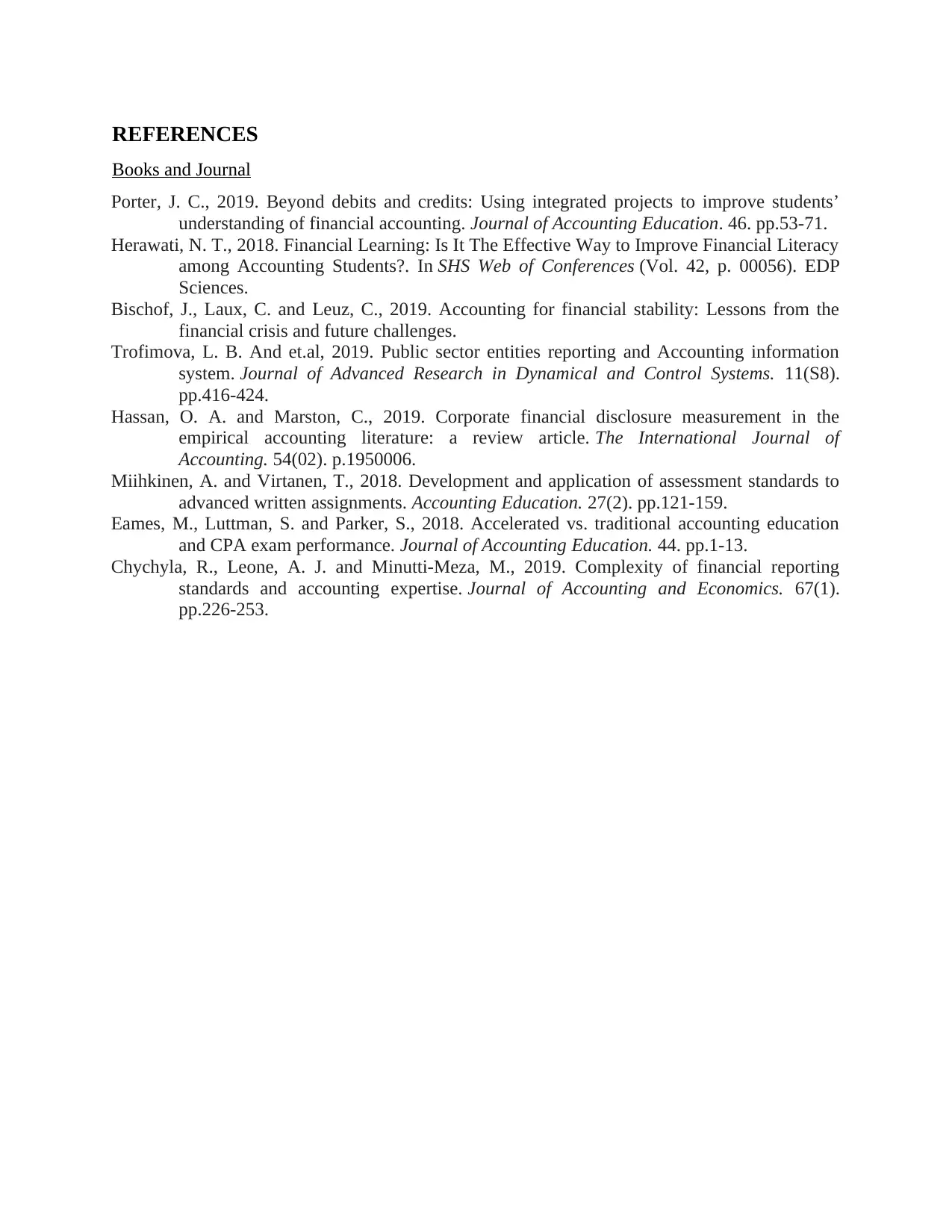
REFERENCES
Books and Journal
Porter, J. C., 2019. Beyond debits and credits: Using integrated projects to improve students’
understanding of financial accounting. Journal of Accounting Education. 46. pp.53-71.
Herawati, N. T., 2018. Financial Learning: Is It The Effective Way to Improve Financial Literacy
among Accounting Students?. In SHS Web of Conferences (Vol. 42, p. 00056). EDP
Sciences.
Bischof, J., Laux, C. and Leuz, C., 2019. Accounting for financial stability: Lessons from the
financial crisis and future challenges.
Trofimova, L. B. And et.al, 2019. Public sector entities reporting and Accounting information
system. Journal of Advanced Research in Dynamical and Control Systems. 11(S8).
pp.416-424.
Hassan, O. A. and Marston, C., 2019. Corporate financial disclosure measurement in the
empirical accounting literature: a review article. The International Journal of
Accounting. 54(02). p.1950006.
Miihkinen, A. and Virtanen, T., 2018. Development and application of assessment standards to
advanced written assignments. Accounting Education. 27(2). pp.121-159.
Eames, M., Luttman, S. and Parker, S., 2018. Accelerated vs. traditional accounting education
and CPA exam performance. Journal of Accounting Education. 44. pp.1-13.
Chychyla, R., Leone, A. J. and Minutti-Meza, M., 2019. Complexity of financial reporting
standards and accounting expertise. Journal of Accounting and Economics. 67(1).
pp.226-253.
Books and Journal
Porter, J. C., 2019. Beyond debits and credits: Using integrated projects to improve students’
understanding of financial accounting. Journal of Accounting Education. 46. pp.53-71.
Herawati, N. T., 2018. Financial Learning: Is It The Effective Way to Improve Financial Literacy
among Accounting Students?. In SHS Web of Conferences (Vol. 42, p. 00056). EDP
Sciences.
Bischof, J., Laux, C. and Leuz, C., 2019. Accounting for financial stability: Lessons from the
financial crisis and future challenges.
Trofimova, L. B. And et.al, 2019. Public sector entities reporting and Accounting information
system. Journal of Advanced Research in Dynamical and Control Systems. 11(S8).
pp.416-424.
Hassan, O. A. and Marston, C., 2019. Corporate financial disclosure measurement in the
empirical accounting literature: a review article. The International Journal of
Accounting. 54(02). p.1950006.
Miihkinen, A. and Virtanen, T., 2018. Development and application of assessment standards to
advanced written assignments. Accounting Education. 27(2). pp.121-159.
Eames, M., Luttman, S. and Parker, S., 2018. Accelerated vs. traditional accounting education
and CPA exam performance. Journal of Accounting Education. 44. pp.1-13.
Chychyla, R., Leone, A. J. and Minutti-Meza, M., 2019. Complexity of financial reporting
standards and accounting expertise. Journal of Accounting and Economics. 67(1).
pp.226-253.
1 out of 11
Related Documents
Your All-in-One AI-Powered Toolkit for Academic Success.
+13062052269
info@desklib.com
Available 24*7 on WhatsApp / Email
![[object Object]](/_next/static/media/star-bottom.7253800d.svg)
Unlock your academic potential
Copyright © 2020–2025 A2Z Services. All Rights Reserved. Developed and managed by ZUCOL.





